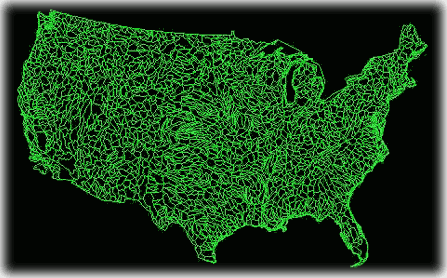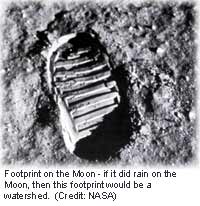When looking at the location of rivers and the amount of streamflow in rivers, the key concept is the river’s “watershed”. What is a watershed? Easy, if you are standing on ground right now, just look down. You’re standing, and everyone is standing, in a watershed.
A watershed is the area of land where all of the water that falls in it and drains off of it goes into the same place. Watersheds can be as small as a footprint or large enough to encompass all the land that drains water into rivers that drain into Chesapeake Bay, where it enters the Atlantic Ocean. This map shows one set of watersheds in the continental United States; these are known as National 8-digit hydrologic units (watersheds).
A watershed is an area of land that drains all the streams and rainfall to a common outlet such as the outflow of a reservoir, mouth of a bay, or any point along a stream channel. The word watershed is sometimes used interchangeably with drainage basin or catchment. Ridges and hills that separate two watersheds are called the drainage divide. The watershed consists of surface water–lakes, streams, reservoirs, and wetlands–and all the underlying ground water. Larger watersheds contain many smaller watersheds. It all depends on the outflow point; all of the land that drains water to the outflow point is the watershed for that outflow location. Watersheds are important because the streamflow and the water quality of a river are affected by things, human-induced or not, happening in the land area “above” the river-outflow point.
Source: http://ga.water.usgs.gov/
Dear User/Visitor! Please, answer on our questions: tick off one of the positions – your answer will make us able to improve our site and make it more interesting and useful!



